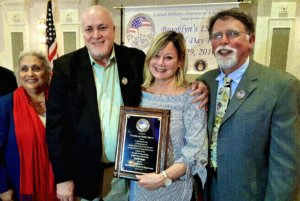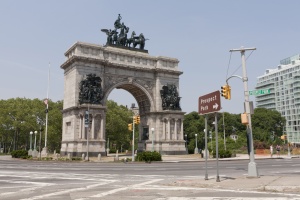In an effort to reduce truck traffic in the northeast, the Port Authority and the Federal Highway Commission are resuscitating the Cross Harbor Freight Program, an age-old project that got new life about a decade ago before being shelved by the Bloomberg administration, but some locals fear it could bring even more big-wheelers to one of the Ridge’s already overcrowded trucking corridors.
“We saw a map of National Highway Congestion, which confirmed that everyone wants to get to Brooklyn – or at least the northeast,” Jayne Capetanakis, chair of Community Board 10’s traffic and transportation committee, told board members at a January 28 meeting. “This northeast corridor for truck traffic is already congested and this impacts freight movement, increasing the costs and environmental impact on the movement of goods, while also impacting safety of roadways and infrastructure.
“It’s only expected that the amount of freight which needs to be moved into this area will be growing,” she went on.
According to The Port Authority, 909 million tons of truck traffic were documented in the northeast region during 2007; that number is expected to rise to 1,272 million tons by 2035.
The project offers 11 proposed alternatives.
Five are waterborne, utilizing barges, ferries or floats to transport railcars across New York Harbor.
In addition, there are five rail/tunnel options in which trains would travel underwater – through a yet-to-be-built 3½-mile tunnel — and emerge at the 65th Street railyard, then head across Brooklyn toward Long Island via the Long Island Railroad right-of-way. These alternatives would include expansion of the right-of-way to allow room for a second track, as well as the relocation of the Buckeye Pipeline carrying jet fuel to Kennedy Airport, which now runs through the right-of-way.
The final alternative is one in which no action would be taken.
The agencies will make a decision which to pursue, with input from affected community boards and residents, this summer.
According to the Port Authority, the waterborne alternatives are expected to lower truck traffic by 600 trucks and cost anywhere from $100 to $600 million while taking an estimated two years to complete, while the rail and tunnel alternatives are expected to lower truck traffic by up to 5,000 trucks and cost anywhere from $7 to 11 billion, taking closer to eight years to finish.
The latter, board Chair Brian Kieran said, could include an entrance or exit at 10th Avenue and 65th Street – a concern to the board because 65th Street already is congested and a high accident location.
But the board’s biggest concerns, Capetanakis said, go far beyond truck traffic.
“We have deep concerns that the vibrations from an increase in trains might impact the infrastructure of the Bay Ridge Towers where these rail cars pass underneath,” she said, in reference to the rail and tunnel alternatives. “[Committee] discussion included whether the type of technology used to lower train vibrations on the Fourth Avenue R train line could also be used to ease any noise and vibrational impact for our neighbors at the Towers.”
A lack of information was also an issue, said District Manager Josephine Beckmann, since the agency cancelled its appearance at a January 12 briefing with the board.
“We did not receive enough data on the actual impact to the 65th Street yard, including space needed for storing the increase of freight containers,” Capetanakis said, noting that, without representatives on hand, both committees were left to sort through a Powerpoint presentation on their own.
Kieran said that, while the board received some more specifics at a January 22 meeting with the Port Authority at Brooklyn Borough Hall, members still have some more talking to do, to determine which alternative they preferred.
Kieran expressed doubt about the rail/tunnel alternatives based on information gleaned at Borough Hall.
“Rail will have a real impact on our community board at 65th and along the rail line for sure,” he said. “Out of these options, there was one waterborne alternative that had the least amount of truck traffic for our area considering, if you’re going to move this cargo by rail somewhere, it has to get on the truck whether it be in Bay Ridge, Dyker Heights, Queens, or [elsewhere].”
“At the end of the day, this is a big deal,” Beckmann told this paper. “We have to make sure we get it right. We have to make sure we do what’s best for the community.”
The Port Authority is taking public comments on the proposal through March 20. The public can send comments to [email protected], and are invited to attend a public meeting on the project at Borough Hall (209 Joralemon Street) on Tuesday, February 3 from 4 to 8 p.m.

 Generally Speaking: Bay Ridge resident named Brooklyn surrogate, Memorial Day Parade-ers honored
Generally Speaking: Bay Ridge resident named Brooklyn surrogate, Memorial Day Parade-ers honored  Captain America celebrates 75th birthday with statue in Prospect Park
Captain America celebrates 75th birthday with statue in Prospect Park